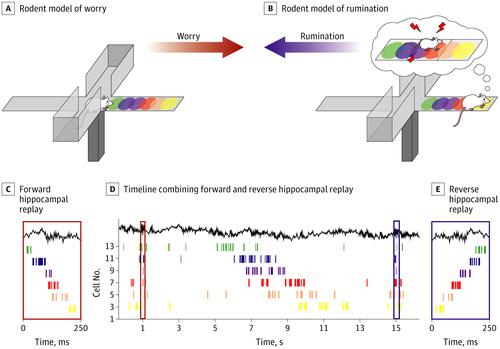JAMA Psychiatry ( IF 25.8 ) Pub Date : 2020-04-01 , DOI: 10.1001/jamapsychiatry.2019.4788 Aaron S Heller 1 , Rosemary C Bagot 2, 3

|
Emotional learning (learning the value of stimuli or contexts) is central to the causative mechanisms of mood and anxiety disorders. During emotional learning, the hippocampus, long implicated in internalizing disorders, receives a snapshot of distributed cortical and subcortical activity. Synaptic plasticity promotes engram formation, the circuit-level instantiation of memory.1 Hippocampal replay, the rapid, coordinated reactivation of encoding-activated cellular ensembles during sleep and resting wakefulness, also supports memory consolidation2 and may contribute to prospection and decision-making. Even in rodent cognitive spatial tasks, learning fundamentally concerns the learning of value, a process critical to psychopathology. While unstudied (to our knowledge) in psychiatric disorders, hippocampal replay abnormalities may critically link animal models with human psychopathology and, in particular, with cognitive symptoms of worry and rumination. Hippocampal replay2 is marked by ripple oscillations in the CA1 local field potential1 of approximately 100 milliseconds at 140 to 250 Hz.2 During replay, which is commonly observed after a rodent traverses a maze (reverse replay) or before it enters a familiar maze (forward replay), the hippocampal firing sequence recapitulates previously observed firing but is accelerated.2 Reverse replay is not observed before an initial maze run, suggesting that replay represents previous experience. Forward replay is observed when, as the rodent approaches a decision point in a familiar maze, hippocampal place cells replay forward the sequences observed previously from that maze.3 Forward replay is associated with the rodent’s ultimate trajectory, potentially representing goal-directed future planning in anticipation of decision-making.3 Hippocampal replay is the replay that has been most extensively studied, yet there is evidence that replay occurs elsewhere, including the prefrontal cortex (PFC), particularly the medial PFC (mPFC). While most evidence supports replay-associated CA1 sharp-wave ripples originating in the CA3, recent findings suggest a role for bidirectional mPFC-hippocampus communication in initiating and, in particular, sustaining replay.4
中文翻译:

海马重播是焦虑和抑郁的机制吗?
情绪学习(学习刺激或情境的价值)对于情绪和焦虑症的致病机制至关重要。在情绪学习过程中,长期与内在失调有关的海马会收到分布的皮质和皮质下活动的快照。突触可塑性促进字母形成,即记忆的电路级实例化。1海马重播,即睡眠和休息清醒期间编码激活的细胞团的快速,协调的激活,也支持记忆巩固2并可能有助于勘探和决策。即使在啮齿动物的认知空间任务中,学习也从根本上关注价值的学习,这是对心理病理学至关重要的过程。尽管尚未研究(据我们所知)精神疾病,但海马重播异常可能将动物模型与人类心理病理尤其是与忧虑和反省的认知症状联系起来。海马重播2的特征是在140至250 Hz时,CA1局部电场电势1中约100毫秒的波纹振荡。2重播期间(通常是在啮齿动物横穿迷宫后(反向重播)或进入熟悉的迷宫之前(正向重播)之前观察到的),海马击发序列概括了先前观察到的击发,但被加速了。2在初次迷宫运行之前未观察到反向重放,这表明重放代表以前的经验。当啮齿动物接近熟悉的迷宫中的决策点时,海马位置细胞向前回放先前从该迷宫中观察到的序列时,观察到正向重放。3前向重播与啮齿动物的最终轨迹相关,可能表示在预期决策的过程中以目标为导向的未来计划。3海马重播是经过最广泛研究的重播,但有证据表明重播发生在其他地方,包括前额叶皮层(PFC),尤其是内侧PFC(mPFC)。尽管大多数证据支持源自CA3的与重放相关的CA1尖波波纹,但最近的发现表明双向mPFC-海马通讯在启动尤其是维持重放中发挥了作用。4



























 京公网安备 11010802027423号
京公网安备 11010802027423号